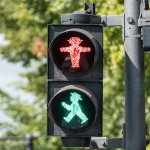International Traffic Light Day Date in the current year: August 5, 2026
 International Traffic Light Day, also referred to as simply Traffic Light Day, is celebrated annually on August 5. It was created to commemorate the installation of the world’s first electric traffic light in Cleveland, Ohio in 1914.
International Traffic Light Day, also referred to as simply Traffic Light Day, is celebrated annually on August 5. It was created to commemorate the installation of the world’s first electric traffic light in Cleveland, Ohio in 1914.Traffic lights, also known as traffic signals or stoplights, are signaling devices designed to control the flow of traffic. The history of their development is closely connected to the history of automobile transport, although the first traffic lights slightly predate modern cars.
Before the invention and introduction of traffic lights the flow of traffic was regulated by traffic police. The first traffic police force was established in London in the early 18th century in response to an increase in horse-drawn traffic on the London Bridge connecting the City of London and Southwark.
The first traffic lights were also installed in London. They were designed by railway engineer and inventor J. P. Knight who was concerned by the growing number of accidents on the streets of London. He proposed a policeman-operated signaling system that used semaphore arms during the day and green and red gas lamps during the night. Knight’s traffic lights were installed outside the Houses of Parliament in December 1868 to control the flow of traffic around Westminster Bridge.
The first electric traffic light was developed in 1912 by American police officer and inventor Lester Wire from Salt Lake City, Utah. Its first prototype was installed in downtown Salt Lake City, but the public’s reaction to the invention was mixed. Wire improved the design, and the improved version of the traffic light was installed by the American Traffic Signal Company in Cleveland, Ohio on August 5, 1914. This day is widely regarded as the birthday of the modern traffic lights.
Early traffic lights had only two colors, red for “stop” and green for “go”. The first three-color traffic light, which incorporated amber (yellow) for “caution”, was designed by William Potts from Detroit, Michigan in 1920.
For the first decade of their existence, electric traffic lights were operated by police officers. In the early 1920s, companies that produced and installed traffic lights began to add automatic timers to their products. Automatic traffic signals helped cities save money by reducing the number of traffic officers. The rise of computers in the 1950s made traffic lights even more efficient thanks to computerized detection systems that measured traffic and changed lights accordingly.
Today, traffic lights are ubiquitous in urban areas around the globe, so it is not surprising that there is a holiday dedicated to them. The origins of International Traffic Light Day are unclear, but it is great that someone came up with the idea of dedicating a holiday to traffic signals because they are an integral part of modern life. You can observe the holiday by learning more about the history of traffic lights, teaching your kids how traffic lights work, and raising awareness on social media with the hashtags #InternationalTrafficLightDay and #TrafficLightDay.
- Category
- Unofficial Holidays
- Tags
- International Traffic Light Day, Traffic Light Day , international observances, unofficial holidays, traffic lights